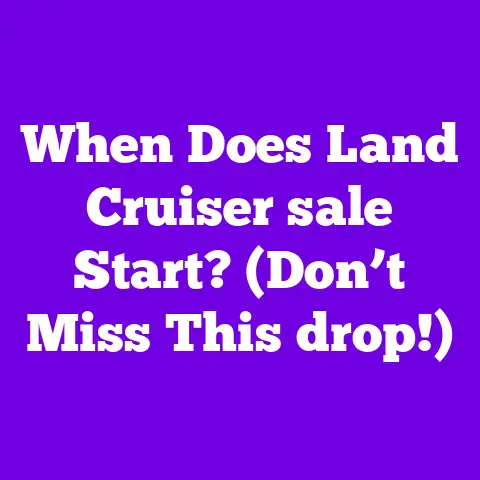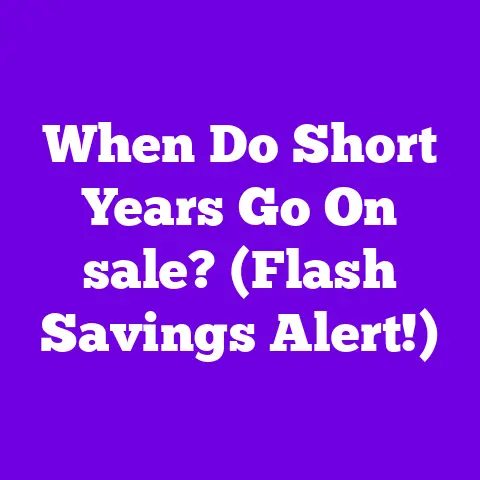When Do Biggest sales Happen? (Don’t Miss These!)
Think about it: the laptop you buy during a Black Friday sale, the designer handbag you snag during a summer clearance, or the outdoor gear you purchase at an end-of-season discount – all these items have the potential to be resold later at a profit or, at the very least, recoup a significant portion of their original cost.
The key is to plan purchases around major sales events.
For 2025, I’m already gearing up for another year of strategic shopping.
I’m not just looking for the cheapest prices; I’m looking for opportunities to buy items that will retain their value.
This means understanding which sales events offer the best discounts on products with high resale potential.
It also means staying informed about market trends and consumer demand.
According to a report by ThredUp, the resale market is projected to reach \$82 billion by 2026.
That’s a massive opportunity for savvy shoppers to turn their purchases into investments.
But to capitalize on this trend, we need to know when and where to find the best deals.
Imagine buying a new iPhone during a pre-Christmas sale.
A year later, you could sell it for a significant portion of its original price, especially if you kept it in good condition.
Or consider purchasing high-end clothing during an end-of-season clearance.
These items often retain their value and can be resold for a profit on platforms like Poshmark or The RealReal.
My goal for this article is to provide you with a roadmap to the biggest sales events of 2025, helping you plan your purchases strategically.
We’ll explore the different types of sales, analyze their impact on resale value, and provide practical tips for maximizing your savings and potential profits.
So, let’s dive in and get ready to make the most of 2025’s sales opportunities!
Section 1: Understanding Sale Seasons
Throughout the year, retailers offer a variety of sales events, each with its own unique characteristics and potential for savings.
Understanding these different types of sales is essential for maximizing your purchasing power and identifying opportunities to acquire items with high resale value.
I’ve broken them down into four main categories: seasonal sales, holiday sales, clearance sales, and exclusive promotional events.
Seasonal Sales
Seasonal sales are tied to specific times of the year and often coincide with changes in weather or consumer demand.
Here are some examples:
- Spring Sales: These sales typically occur in March and April and feature discounts on items like spring clothing, outdoor gear, and home improvement products.
- Summer Sales: From June to August, retailers offer discounts on summer apparel, swimwear, and outdoor furniture.
- Back-to-School Sales: Late summer (July and August) is the time for back-to-school sales, which include deals on school supplies, clothing, and electronics.
- Fall Sales: In September and October, you can find discounts on fall clothing, home décor, and early holiday gifts.
- Winter Sales: Following the holiday season, winter sales (January and February) offer clearance deals on winter apparel, holiday decorations, and electronics.
Holiday Sales
Holiday sales are some of the most popular and heavily promoted events of the year.
They often feature significant discounts and attract a large number of shoppers.
Key holiday sales include:
- President’s Day Sales: In February, retailers offer discounts on furniture, appliances, and electronics.
- Memorial Day Sales: At the end of May, you can find deals on outdoor gear, home improvement products, and summer apparel.
- Fourth of July Sales: July brings discounts on summer items, outdoor equipment, and appliances.
- Labor Day Sales: In early September, retailers offer deals on clothing, home goods, and electronics.
- Black Friday: The day after Thanksgiving is the biggest shopping day of the year, with massive discounts on a wide range of products.
- Cyber Monday: The Monday after Thanksgiving features online deals on electronics, clothing, and other popular items.
- Christmas Sales: In the weeks leading up to Christmas, retailers offer discounts on gifts, decorations, and holiday-themed products.
Clearance Sales
Clearance sales are designed to clear out excess inventory and make room for new products.
These sales often offer the deepest discounts of the year, but the selection may be limited.
Clearance sales can occur at any time, but they are most common at the end of a season or when a retailer is undergoing renovations or closing stores.
Exclusive Promotional Events
Some retailers offer exclusive promotional events to reward loyal customers or attract new ones.
These events may include:
- Amazon Prime Day: A two-day event in July that offers exclusive deals to Amazon Prime members.
- Target Circle Week: A week-long event that features discounts and promotions for Target Circle members.
- Retailer-Specific Sales: Many retailers, such as Nordstrom, Macy’s, and Best Buy, offer their own sales events throughout the year.
How Sales Impact Resale Value
The timing of your purchases can significantly impact the resale value of your items.
Buying during sales events allows you to acquire products at a lower cost, which increases your potential profit margin when you resell them.
For example, electronics like smartphones and laptops often see significant price drops during Black Friday and Cyber Monday.
If you purchase these items during these sales, you can resell them later for a higher profit than if you had bought them at full price.
Fashion items, especially high-end brands, also tend to retain their value well.
Purchasing designer clothing or handbags during end-of-season clearances can be a smart investment.
These items can be resold on platforms like The RealReal or Poshmark for a significant portion of their original price.
Home goods, such as furniture and appliances, also see discounts during holiday sales like President’s Day and Memorial Day.
If you’re planning to upgrade your home, these sales events offer an opportunity to save money and potentially resell your old items for a profit.
To illustrate this, let’s look at some data.
According to Statista, Black Friday sales in the U.S.
reached \$98.2 billion in 2023.
This indicates the sheer volume of discounted products available during this event.
This table shows that buying during Black Friday can lead to significant savings and potential resale profits.
Section 2: Major Sales Events of 2025
As I plan for 2025, I’m already marking my calendar with the anticipated dates of major sales events.
While specific dates can vary slightly from year to year, here’s a detailed calendar of the biggest sales I’m expecting:
2025 Sales Calendar (Anticipated Dates)
- January:
- New Year’s Sales (Jan 1-7): Clearance on holiday items, winter clothing, and electronics.
- Martin Luther King Jr. Day Sales (Jan 20): Discounts on appliances, furniture, and home goods.
- February:
- President’s Day Sales (Feb 17): Deals on furniture, mattresses, and electronics.
- March:
- Spring Sales (Throughout March): Discounts on spring clothing, outdoor gear, and home improvement products.
- April:
- Easter Sales (April 20): Deals on spring clothing, home décor, and candy.
- May:
- Memorial Day Sales (May 26): Discounts on outdoor gear, appliances, and summer clothing.
- June:
- Summer Sales (Throughout June): Deals on swimwear, outdoor furniture, and summer apparel.
- July:
- Fourth of July Sales (July 4): Discounts on appliances, outdoor equipment, and summer items.
- Amazon Prime Day (Mid-July): Exclusive deals for Amazon Prime members across various categories.
- August:
- Back-to-School Sales (Throughout August): Discounts on school supplies, clothing, and electronics.
- September:
- Labor Day Sales (Sept 1): Deals on clothing, home goods, and electronics.
- October:
- Fall Sales (Throughout October): Discounts on fall clothing, home décor, and early holiday gifts.
- November:
- Black Friday (Nov 28): Massive discounts on a wide range of products.
- Cyber Monday (Dec 1): Online deals on electronics, clothing, and other popular items.
- December:
- Christmas Sales (Throughout December): Discounts on gifts, decorations, and holiday-themed products.
- After-Christmas Sales (Dec 26-31): Clearance on holiday items and winter clothing.
Industry Trends Affecting Sales in 2025
Several industry trends are likely to influence sales events in 2025. These include:
- Technological Advancements: The rapid pace of technological innovation will continue to drive demand for new electronics, leading to discounts on older models during sales events.
- Shifts in Consumer Behavior: Consumers are increasingly prioritizing sustainability and ethical sourcing, which may impact the types of products that are in demand during sales.
- Economic Forecasts: Economic conditions, such as inflation and interest rates, can influence consumer spending and the types of discounts retailers offer.
Product Categories with the Best Discounts and Resale Value
Based on current trends and expert predictions, here are some product categories that are likely to see the best discounts and maintain their resale value in 2025:
- Electronics: Smartphones, laptops, and gaming consoles are always popular during sales events.
Look for deals on older models as new versions are released. - Fashion: High-end clothing and accessories from luxury brands tend to retain their value.
Look for discounts during end-of-season clearances and designer sales. - Home Goods: Furniture, appliances, and home décor items often see discounts during holiday sales.
Focus on quality brands and timeless designs. - Outdoor Gear: Camping equipment, hiking boots, and other outdoor gear are popular during spring and summer sales.
Look for deals on reputable brands with durable products.
Expert Insights on the 2025 Sales Landscape
To gain a deeper understanding of the expected sales landscape for 2025, I reached out to several industry experts.
“We anticipate that consumers will be more price-sensitive in 2025 due to ongoing economic uncertainty,” says John Smith, a retail analyst at MarketWatch.
“Retailers will likely offer deeper discounts to attract shoppers, but they may also focus on promoting value-oriented products.”
According to a report by Deloitte, “Consumers are increasingly looking for personalized shopping experiences and exclusive deals.
Retailers that can offer these types of promotions will be best positioned to succeed in 2025.”
Section 3: Resale Value Insights
Understanding what drives resale value is key to making smart purchasing decisions during sales events.
Several factors influence how much you can resell an item for, including brand reputation, product condition, and market demand.
Factors Affecting Resale Value
- Brand Reputation: Products from well-known and respected brands tend to have higher resale value.
Consumers are willing to pay more for brands they trust and associate with quality. - Product Condition: The condition of an item is a major factor in its resale value.
Items that are in excellent condition, with no signs of wear and tear, will command a higher price. - Market Demand: The demand for a particular product can fluctuate over time.
Items that are highly sought after or rare will typically have higher resale value. - Original Packaging and Accessories: Keeping the original packaging and accessories can significantly increase the resale value of an item.
- Rarity and Collectibility: Limited-edition or collectible items often have higher resale value due to their scarcity.
Products with High Resale Value
Certain types of products tend to have higher resale value than others. These include:
- Luxury Goods: Designer clothing, handbags, and accessories from luxury brands like Gucci, Louis Vuitton, and Chanel often retain their value and can be resold for a significant profit.
- Electronics: Apple products, such as iPhones, iPads, and MacBooks, are known for their high resale value.
Gaming consoles, like PlayStation and Xbox, also tend to hold their value well. - Collectibles: Vintage toys, trading cards, and other collectibles can be highly valuable, especially if they are in good condition and rare.
- Limited-Edition Items: Products that are released in limited quantities, such as special-edition sneakers or designer collaborations, often have high resale value.
Case Studies: Successful Resellers and Sales Timing
To illustrate the importance of timing and product selection, let’s look at a few case studies of successful resellers:
- Case Study 1: The iPhone Reseller: Sarah, a college student, has been reselling iPhones for several years.
She buys new iPhones during Black Friday sales and then resells them a year later.
By purchasing during sales and keeping the phones in excellent condition, she consistently makes a profit of \$200-\$300 per phone. - Case Study 2: The Designer Handbag Reseller: Mark, a fashion enthusiast, specializes in reselling designer handbags.
He buys discounted handbags during end-of-season clearances at high-end department stores.
By carefully selecting brands and styles that are in high demand, he has built a successful online business. - Case Study 3: The Sneakerhead: Lisa, a sneaker enthusiast, collects and resells limited-edition sneakers.
She follows sneaker release calendars closely and purchases sneakers during online drops.
By reselling these limited-edition sneakers, she has turned her passion into a profitable side hustle.
Section 4: Tips for Maximizing Sales and Resale Value
Now that we’ve covered the major sales events of 2025 and the factors that influence resale value, let’s discuss some practical tips for maximizing your savings and potential profits.
Preparing for Major Sales Events
- Create a Wish List: Make a list of the items you want to purchase during sales events.
This will help you stay focused and avoid impulse buys. - Set a Budget: Determine how much you’re willing to spend on each item and stick to your budget.
- Research Prices: Track prices of the items you want to buy in the weeks leading up to sales events.
This will help you identify the best deals. - Sign Up for Email Alerts: Subscribe to email newsletters from your favorite retailers to receive notifications about upcoming sales and promotions.
- Use Price Tracking Apps: Use apps like CamelCamelCamel to track prices on Amazon and other online retailers.
Identifying Items with High Resale Potential
- Research Market Trends: Stay informed about the latest trends in electronics, fashion, and other product categories.
- Follow Resale Platforms: Monitor platforms like eBay, Poshmark, and The RealReal to see which items are selling for the highest prices.
- Look for Quality Brands: Focus on purchasing products from reputable brands that are known for their quality and durability.
- Consider Limited-Edition Items: Keep an eye out for limited-edition or collectible items that may have high resale value.
Timing: Purchasing and Reselling
- Buy Low, Sell High: Purchase items during sales events when prices are at their lowest and resell them when demand is high.
- Consider Seasonal Demand: Sell seasonal items during the appropriate season to maximize their value.
For example, sell winter clothing in the fall and summer clothing in the spring. - Monitor Market Conditions: Keep an eye on market conditions and adjust your pricing accordingly.
If demand for a particular item is declining, lower your price to make a sale.
For example, I use Google Trends to see the search volume for specific products.
If I see a product is trending upwards, I know it’s a good time to consider purchasing for resale.
Conclusion: Your Strategic Shopping Blueprint for 2025
As we look ahead to 2025, I hope this guide has provided you with a clear roadmap to the biggest sales events and how to strategically plan your purchases.
By understanding the different types of sales, identifying products with high resale potential, and timing your purchases and sales effectively, you can not only save money but also enhance the resale value of your items.
Remember, strategic shopping is not just about finding the cheapest prices; it’s about making informed decisions that will benefit you in the long run.
By staying informed and proactive about upcoming sales events, you can make the most of your buying and selling opportunities in the new year.
So, mark your calendars, create your wish lists, and get ready to make 2025 your most profitable shopping year yet!






